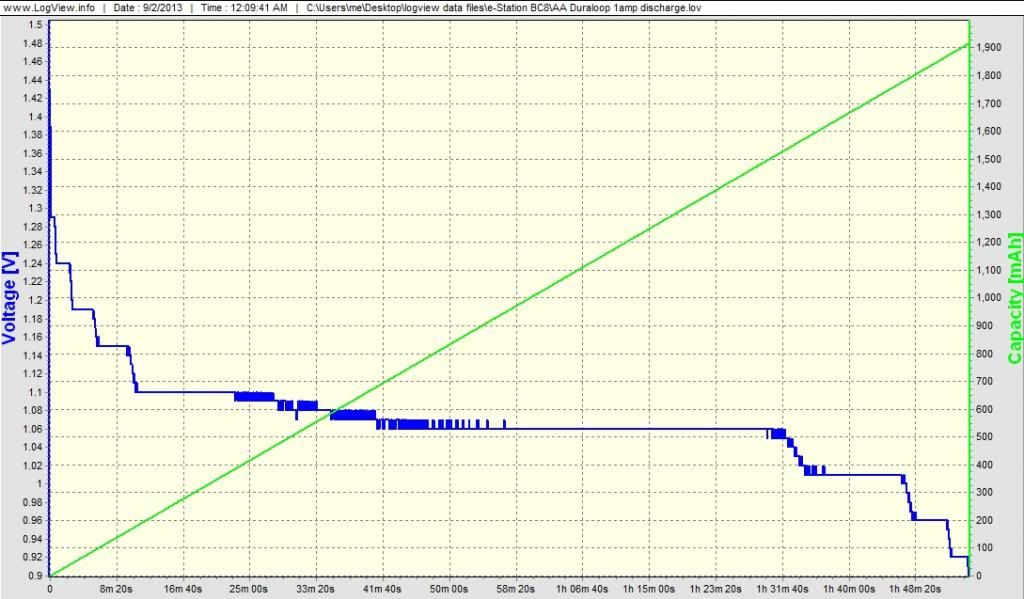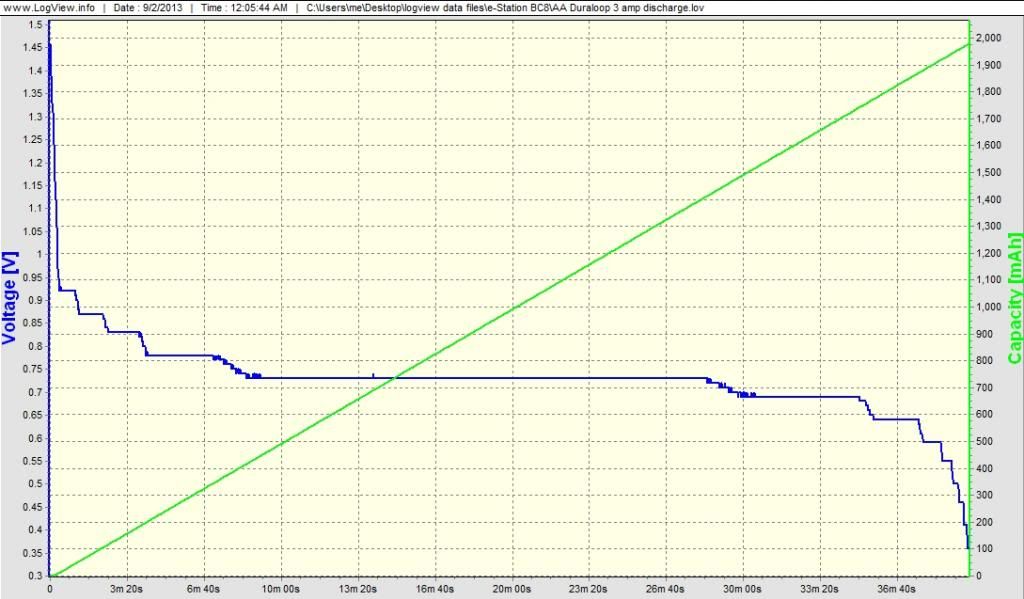*UPDATE: For some reason unknown to me the charger was reading a error of about .40v below the actual voltage in the 3 amp discharge graph and about .20v to low in the 1 amp discharge graph.
.
I was one of those crazy people that rushed out to get in on the target Duraloop clearance sale. I did some research on trying to find out if they where really eneloop’s. I could never find a discharge graph comparison between the two.
And everywhere I looked said it had not been proven but by all accounts they where eneloop’s.
So I decided I would run a couple of discharge test using logview and a accucell 8150 on the duraloop’s since I dont own any true eneloop’s I could not compare them directly. But there is plenty of discharge graphs on the net with the eneloop. This is what I came up with.
This test was preformed at a 1 amp discharge rate.
.

.
I can see that the duraloop resembles the discharge curve of a eneloop but it seems the load voltage is lower than what I would expect from eneloop graphs I have seen.
.
.
Next test is at a discharge rate of 3 amps. This is where the duraloop just dont seem to compare to the eneloop.
.

.
.
The duraloop would not hold a voltage over .9v but for a few minutes under a 3 amp load. I thought eneloop’s where known for their high discharge current capabilities. I had to set the cut off point on the charger at .3v just to be able to see what was going on or the charger would trip from low voltage. The duraloop does hold its voltage very well under the 3 amp load at about .73v. But I would have expected the voltage to be much higher. I did check the cell voltage about 30 minutes after the test, it measured 1.217v.
Here are some discharge graphs from sanyo.
.
http://www.eneloop.info/fileadmin/web_data/Data-Sheets/HR-3UTGB.pdf
.
As you can see they have almost the same curve as mine but the voltages are much lower. Even at the 4 amp discharge rate in the sanyo graphs far exceed my duraloop graphs.
I know that was probably a hand picked cell out of thousands that sanyo done the test graph on and mine are 9 months old or so. But come on, could they really be that much difference. Whats your thoughts?
Sounds like you need to run the exact test on some eneloops.
+1
Or peel one to see if the OEM left a mark under the retail wrapper…
(Maybe I should be glad I only got 8…?)
Heh, very nice …
I would love too, but I cant see spending 5 times as much for the same cell (if that is the case) just to satisfy my curiosity when I have 40 of them laying around now.
There have been several people over at the other forum that have run discharge graphs on the eneloop’s and they dont ressemble mine as far as load voltages compared to my duraloop’s. ![]()
If you’ve got 40 maybe swap somebody for a couple (temporarily if they want)?
Who would swap them now, after seeing the graphs. :bigsmile:
Good show, moderator007.
There were two types of Duracell. One is the newer with “Duralock” feature. Are your Duracel with Duralock? Asking because the newer Duralock must be different formula and it is perhaps inferior.
Good show, moderator007.
There were two types of Duracell. One is the newer with “Duralock” feature. Are your Duracel with Duralock? Asking because the newer Duralock must be different formula and it is perhaps inferior.
Actually I have both. Most where with the Duralock but a few where not. There’s no way for me to tell now. I just opened them all up and charged them. Then put in my storage container. I do however have 2 packs (8 AA Duraloop’s) charging right now. One was a non duralock pack and the other a duralock pack. I will test all 8 batteries and see if there is any difference. I know at least 4 out of the 8 of those where non duralock. If there’s a difference in duralock and non duralock it should show up in a few discharge test with that 8.
Very interesting...
Would be nice as some pointed out, if you could do the same tests with real eneloops.
They all have the white tops?
They all have the white tops?
White tops and made in japan with date codes near the end of last year.
I really wonder how eneloop does that.
Off topic:
I've seen people mentioning buying 2nd gen. eneloops with date codes of last year, while in Japan we already had 3rd gen since 2011.
Did they use different factories?
You really do need eneloops to compare since your test may have some error, or the tests your using from others may have error, so unless you use the same testing apparatus you can’t directly compare your results to someone elses since there is no way to compare calibration or testing differences.
also there are different generations of eneloops
i do agree with the OP that there is no proof so far that the duracells are rebadged eneloops
Something is wrong with this testing if it shows the battery as not even being able to hold .9V at a 3A load AND a plateau voltage of less than .75V. If you look at tests of other NiMH AA batteries, you will see that ANY NiMH battery out there can hold over .9V at a 3A load. If this testing shows that a Duraloop can’t do something that ANY NiMH AA can do (or even that alkaline batteries can do), then I say there is something wrong with the testing. After all, I’ve NOT found Duraloops to be inferior batteries to basically everything else out there.
Duralock means nothing.
StayCharged are eneloop.
Also, only 1.06V at plateau with a 1A draw? According to testing on the other forum, even cheapo Thunderbolt Magnum batteries from Harbor Freight do better than that. If Thunderbolt Magnums can do it, there’s DEFINITELY a problem with the testing.
I do however have 2 packs (8 AA Duraloop’s) charging right now. One was a non duralock pack and the other a duralock pack. I will test all 8 batteries and see if there is any difference. I know at least 4 out of the 8 of those where non duralock. If there’s a difference in duralock and non duralock it should show up in a few discharge test with that 8.
I am pointing out Duralock because AFAIK Eneloop does not have the feature. This brings up the issue of if Duraloop w/ Duralock is made by Sanyo, why then there is no Eneloop w/ Duralock. This occurred to me only after I opened the package, regretfully.
Or, maybe Duralock is nothing more than a promo hype.
Believe the white top MIJ is Eneloop is based on the fact that Duracell does not have battery factory in Japan, thus white top battery must be Eneloop.
Post the details of your test setup - looks like you’ve got excessive voltage drop.
Duralock appears to be nothing more than a catchy phrase on the part of Duracell. And given the fact that even their non-LSD batteries (like the 2450s) carry that label, it would appear that the term is rather meaningless.